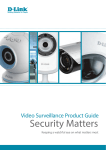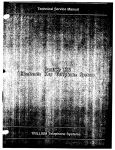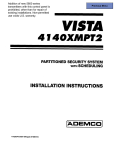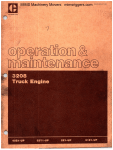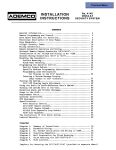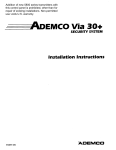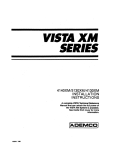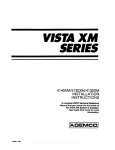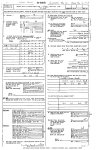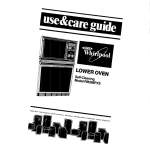Download ADEMCO 5130XM Programming instructions
Transcript
Previous Menu ViSI!!IiIA SERIES XM 4140XM/51 30XM/4130XM INSTALLATION INSTRUCTIONS A complete VISTA T=hnioal Reference Manual that oan unlock the full power of the VISTA XM System is available. See inside front cover for more information. il 92V3 7/90 CONGRATULATIONS and WELCOME to the VISTA XM FAMILY! The purpose of these Installation Instructions is to give you, the installer, a brief ovemiew of the VISTA XM system, and provide instructions for installing a basic system. For more complete informati~ rncluding descriptions of the VISTA XM series of products, detailed wiring diagrams and complete programming instructions, please refer to the VISTA XM TECHNICAL REFERENCE WAL, available fmm our Technical Support Group (call one of the numbers listed below), or you can pick one up at your local Ademco Distribution center. As always, ADEMCO is there for YOU! Our SALES and TECHNICAL SUPPORT staff are eager to assist you in any way they can, so don’thesitate to call, for any reason! East Coast Technical Support: 1-800-645-7492 (8 a.m.-6 p.m. E.S.T.) West Coast Technical Support: 1-800-458-9469 (8 a.m.-5 p.m. P.S. T.) Ag@ CONGRATULA’IIONS,and WELCOME ABOARD! -2- Dear Valued Cuatomet% To help provide you with the best possibie products and semice, piease take a few minutes to compiete this survey and drop it in the maii. We vaiue your comments and iook forward to hearing from you soon. Thank You. YourCompanyNarm phoneNumbaK CustomerNumber 4140XM 1,whichVISTAXM systemwas installect? 2. a) Waswirelessusad? b) How my 5130XM Yes No 1 4260s (or4260-8s)used? Yes 3. Wastwo-wuaexparmonusad? If yes,whtchdaVICaS wareused(checkallthatapply)? —4190WH2Zona Module _ 42088 ZoneModule _ 4139 Mm SurfaceM~-~~ntacf _ 4191 MmlRa@aaad — 4194wIda Gsp Readcontact 4130XM 2 No _ _ _ _ _ 4192SDPhotodectncSmokeDetector 4192SDTPhotoaiactnc SmokeDetectorw/HeatDetector 4 192CPIonzstionSmokeDetector 4275 DualElementPIR 4196 QuadElementPtR 4. a) How wouldyouratethe new,158 page7ECHNOU REFEREKE AMNUAL overall?(availabbat AdamcoDIstribumnCanters) Poor Fair Didnotuaetha TRM Excellent b)lfyouchosa poororfair,whatarasoma reasons?Pleasebe Specific. 5. a) DidyoudOwIIIOSd the program? b)lfyea, waaiteaayto dosndunderstand? Yas No Yaa No c) If no, whynot?Pleasebe specific. d) Didyouusetheramotecommandfeature? Yae No e) If yes,are thereanyotherfasturaahrnmandsyouwoutdIikato sea?Piaaaabe apacifc. 6, a) Didyoup~ram viathe keypad? b)lfyea, wasiteasy todoandundmtmd? Yes No Yea No c)lfno, whynot? PlaasebasPecm. 7. What wouldyouhketo sea n the future? outputs? controlfunctions? other’?” 8. Additii commentsor suggastii. Putof N5192V3 7/90 B4 33SS3Wl~V AQ CllVd 3S llIM 39VlSOd L6L11AN ‘J3SSOAS ● S81 “ONllMH3d SSVW lSldId 0klV3 Ald3M SS3NIW19 s3LvJs a311Nn 3H.1Nl agmvbvdI AMVSS323N 39VlSOd ON II PLEASE FOLD TH)S MAILER ALONG SCORED LINES SO THAT THE BUSINESS REPLY PORTION FACES OUT, SEAL IT WITH TAPE OR STAPLE, AND OROP IT IN THE MAIL. THANK YOU FOR YOUR HELP! TABLE 1. GENERAL Il. ZONE OF CONTENTS lNFORMATION ........................................................................4 TYPE DEFINITIONS ......................................................................5 !11. SYSTEM CONFIGURATION A. (ZONES) .............................................................................................................. 6 B. (Peripherals) ..............................................................................................8 AND POWERING THE SYSTEM ..........................Io IV. MOUNTING v. SYSTEM OPERATION ............................................................................... 13 W. SYSTEM WI. PROGRAMMING COMMUNICATIONS VIII. TESTING ............................................................I 4 THE SYSTEM ......................................................... 15 THE SYSTEM .......................................................................... 16 IX. SPECIFICATIONS — DIP SWITCH TABLES ....................................................................................... 18 — 4140XM — 4130 XM/5130XM — PROGRAMMING FORM.....................................................................................21 SUMMARY ........................................................................................ 17 OF CONNECTIONS SUMMARY DIAGRAM ........................... 19 OF CONNECTIONS NOTE: Retorences to tho 4140XM 4140ATX Controls. refer to both DIAGRAM ........2O the 4140XM ●nd ,.+ -3- 1. GENERAL INFORMATION MEMORY-OF-ALARM The VISTA Controls provide a memory-of-alarm feature, which, upon disarming the system, automatically displays all zones that were in an alarm condition while the system was armed. In addition, a 10 day alarm/trouble history is maintained by the system, which helps the installer or central station to identify problem sensors. To activate this feature, enter the security code + the [0] key. THE VISTA CONTROLS The VISTA XM Controls are microprocessor baaed programmable systems and feature EEROM memory technology (power loss doea not result in the ioes of information), The Controls support up to 9 wired zones of protection, expandable to 64 zonea (wired and/or wireless) when connected to a 2-wire poliing loop. EASY PROGRAMMING Programming can be performed at the office prior to installation, or on the job site directly from the keypad, or can be downloaded from a remote location by using the Ademco 4130PC Downloading Software. BUILT-IN USER’S MANUAL ●nd DESCRIPTION REVIEW For end-user convenience, the 5130XM and 4140XM (with 5137) contain a built-in Users Manual. By depressing and holding any of the function keys on the console for 5 seconds, a brief explanation of that particular function scrolls across the alpha-numeric display. For instalier convenience, the Control is preprogrammed with a set of standard values that is designed to meet the needs of many installations. Theaa values, however, can be changed to suit the needs of any particular installation. The Control can also be pre-programmed by the installer with one of four standard communication default programming values, eliminating the need for extensive programming time and effort. In addition, all programmed zone descriptors can be displayed (one at a time) by pressing and holding the READY key for 5 seconds, then releasing the key. This sewes as a check for installers to be sure all descriptors are entered properly. E%sn Three technologies to suit everv installation: HARDWIRE, SiJPERVISED WiRELESS, 2-WIRE MULTIPLEX VISTA XM CONTROL 2-WIRE MULTIPLEX LOOP Q mm XM v 2-wrm m 4208 &ZONE EXPANDER 2-WIRE Dl%%i’+Em J 1 t-‘ 41S2SDT gl4192CP Y TOADLXTIONAL 2WIRE INTELLIGENT DEvICES 4191of 4129 2WIRE 419QWH EXPiiiiiR 9HAROWIRED ZONES (STANDARD) DooRfwlNDw TRANSMITTER 5711WM -4- I RFRECEIVER [UPTo2 CAHSEUSEDI ::;: y J 41%Qf 4275 42mU g T@ DErEcm G!il WIRELESS SE WIRELESSn PANIC BuTT~ 5ml ~ Il. ZONE TYPE DEFINITIONS Each zone must be assigned to a zone type, which defines the way in which the system responds to faults in that zone. In addition, there are three keypad activated zones (PANIC keys), a polling loop supervision zone, and two RF receiver suparvisoty zones. TYPE 7: 24 HOUR AUDIBLE TYPE 1: ENTRY/EXIT #1 This type is also assigned to a zone containing a Used for the primary entry/exit route (ex: front door, main entrance). Panic button, but which will initiate an audible alarm in addition to an alarm report to the Central TYPE 2: ENTRY/EXIT #2 Station (ex: bedside panic). Used for a secondary entry/exit route (ex: Garage door, loading dock door, basement door), where more time might be needed to get to and from the keypad. TYPE 3: PERIMETER BURGLARY Used for exterior doors and/or windows which require an instant alarm when violated. TYPE 4: BURGLARY INTERIOR (FOLLOWER) Used for areas where an ●ntry delay is required only if an entrytexit delay zone is fautted first. TYPE 5: DAY/NIGHT BURGLARY Used for zones which contain a foil-protected door or window (such as in a store), or to a zone covering a sensitive area such as a stock room, drug supply room, etc., or other controlled access area where immediate notification of an entry is desired. TYPE 6: 24 HOUR SILENT ALARM This zone type is generally assigned to a zone contahing a Hotd-up or Panic button that is designed to initiate an alarm report to the Central Station, but which produces no visual dispfays or alarm sounds (ex banks, jewelry counters). TYPE 8: 24 HOUR AUXILIARY This type assigned 10 a zone containing a button for use in personal emergencies or to a zone containing monitoring devices such as water sensors, Temperature sensors, etc. Designed to initiate an alarm report to the Central Station and only provides Consoie alarm sounds and alarm displays. TYPE 9: SUPERVISED FIRE Used for zones containing smoke detectors, heat detectors, pull stations, etc. Art open in this zone will initiate a trouble signal. A short in this zone will initiate a fire alarm (pulsed external sounder and report to central station). INTERIOR TYPE 10: BURGLARY (DELAYED) This type is similar to type 4, except that entry delay begins whenever sensors in this zone are violated, regardless of whether or not an entry/exit delay zone was faulted first. -57 $3 Ill. (A) SYSTEM CONFIGURATION — BASIC 9 HARD-WIRED ZONES ZONE 1 Thii zone has a 350 miltiind response and can be assigned to any zone type and can be sat up for EOLR supervision or for closed-circuit unsupervised use. Thii zone is the only zone that can support 2-wire smoke detectors (up to 3 BRK detectors) using an EOLR configuration. If EOLR supervision is required, connect all cloaedcircuit sensors in series with one another to TBl 2, (4130XM/5130XM use RED/YELLOW & WHITE/BROWN wires) with the 13,000 ohm resistor in series with the loop, at the last device and then return the loop to TB2-4. If no supervision is required, simply maintain a closed loop with all sensors connected in series with the 100p, beween TB1 -1 and T61.2 (or WHfTE/BROWN & ORANGE). If the sensors used are open-circuit devioes, such as smoke detectors, each one must be in parallel to the next using the EOLR configuration. The EOLR must then be placed across the last wired detector. (ZONES) — ZONES 2 THROUGH 8 These zones have a 35o millisecond response and can be assigned to any zone type. They can be EOLR supervised or closed circuit unsupervised, as required (program field “41 determines whether or not these zones will use the 1,000 ohm EOLR: Enter [1] in fmld ●41 to disable the use of EOLRS on zones 2 through 8). If programmed for use with EOLRS, both closed-circuit and open-circuit devices can be used with the 1,000 ohm EOLR resistor in series with the loop at the last device. If the use of EOLRS is disabled (“41=1), only closed-circuit devices can be used. Note that the maximum resistance per zone is 300 ohms. ZONE 9 This zone is an unsupewised, fast response zone (5-1 O milliseconds), and can be assigned to any zone type except fire. Only closed-circuit devices can be used in this zone. This zone should be used for fast response devices such as fast acting glass break sensors or vibration sensors. Avoid using mechanical magnetic or relay type contacts in this zone. Note that the maximum resistance for this zone is 100 ohms. — ZONE EXPANSION MODULE— (Required 4171 XT-X for zones M/4152LMB To expand the system using a 2-wire Polling Loop and/or wireless devices, a 4171 XT-XM dialer board, and a 4152LMB Loop Module must be installed as shown below. (The 4171 XT-XM is factory installed in the 4140XM.) Wires from the 4208 Zone Expander, RPMs, and 4280 are connected to Terminals 1 & 2 on the 4152LMB. -6- 10 through 64) — 2-WIRE POLLING LOOP EXPANSION (Zones 10 through Wire each of the RPMs in parallel to the 2-wire polling loop, making sure no more than the maximum allowable wire length is used per individual polling loop run, as follows: gauge gauge gauge gauge 64) CAUTION If an intercom system is being used, the polling loop wires must be as far from the intercom wiring as possible (minimum 6-). If this spacing cannot be achieved, shielded wire must be used. If this is not done, interference on the intercom system might occur. Also note that the maximum total wire length supported is cut in half when shielded wire is used. GENERAL INFORMATION To expand the system using a 2-wire polling loop and remote point modules (RPMs), a 4171XT-XM dialer board, and a 4152LMB loop module must tM installed,as describedin the ZONE EXPANSION MODULE section. #22 #20 #18 #18 — ADVISORY The maximum allowabte current draw on the polling loop is 64mA. Refer to the Polling Loop Current Draw Worksheet (found in the POWERING THE SYSTEM section of this manual) for current draws of various polling loop devices. If more than 64mA is bdng drawn, use of the 4197 provides another loop with 64mA available. Refer to the instructions provided with the 4197, or the Technical Reference Manual for complete information. @ 650’ max @95Cr’max @l 500’ max @2400’ max NOTE: Twisted pair recommended for ail normal wire runs. IMPORTANT: The maximum combined polling loop run is 4000’. If using shielded wire, the maximum is 2000’. If longer wire runs are needed, a 4197 Loop Extender Module must be used. — WIRELESS EXPANSION— The VISTA XM system supports up to 63 Alert Ill Transmitters, plus a wireless keypad. To expand the system using wireless, one or two 4280 RF Receivers (or 4280-8 if only 8 wireless zones are used) must be connected to the polling loop. The 4280 can receive signals from wireless transmitters within a nominal range of 200 feet. In addition, two 4280s can be used to provide either a greater area of coverage, or to provide redundant protection. Note that if using 2 RF Receivers; one of them must be powered from Auxifiary power. IMPORTANT: All RF zones must be designated as such in their respective program fields. If using a 4280-8, only up to 8 zones can be enabfed as RF zones. If more than 8 zones are enabled, the message “SET-UP ERROR” (5130XM/51 37) or “E~ (41 30 XM/41 37) will be displayed. For more information regarding the 4260 installation, refer to the Installation Instructions provided with the 4280. WIRELESS PERIPHERALS SMOKE ~DEW@ 4220 DOOR OR 42S0-6 RF RECEIVER . 4 VISTA CONTROL . 415P LMeo T POLLING * a RPMDEVICES LOOP RPM I BASIC9 HARD-WIREDZONES I COMBINATIONCONFIGURATION USING MARDWIRE,2-WIREPOLLINGLOOP AND WIRELESSTECHNOLOGIES -7- 111. (B) SYSTEM CONFIGURATION — REMOTE GENERAL Both the 4130XM and the 5130XM supply up to 280mA (200mA for UL certificated installations) of auxiliary power for remote consoles and/or other auxiliary devices such as motion detectors or 4wire smoke detectors. The 4140XM supplies up to 700mA for non-UL usage and up to 400mA for UL applications. You must keep this in mind when adding remote consoles so you dorm over-draw current from the panel. This would result in a battery which is never fully charged, or possibly a blown auxiliary power fuse. Up to 7 remote consoles can be used. In the event you need more than the allowed number of remote consoles, you can use a second 1350 power pack to power up to 7 extra 4137s/5137s. Instead of using the panef’s auxiliary power connection to the red and black console lead, connect the Positive (+) terminai of the 1350 to the biue console fead, and the Negative (-) to the black iead. As iong as AC power is present these extra consoles are active. If AC is lost, the system’s back-up battery will take over and oniy the consoles powered from auxiliary power wiii be active. — CONSOLES — NOTE If using a 4140XM, make sure you power at least one remote console from auxiliary power, othenviee there wouid be no means of controlling the panel during an AC ioas. 4137 - For use with the 4130XM, 4140XM or 5130XM Controls - 60 mA current draw - Power up to 7 consoles from the 4140XM.(non-UL) 5137 . For use with the 4140XM or 5130XM Controls -60 mA current draw standby -90 mA current draw with backlighting - Power up to 7 consoles from the 4140XM (non-UL) SMOKE DETECTOR CONFIGURATIONS ZONE 1 When programmed as an EOLR supervisedFiRE zone (type 09 in program field “02), up to three 2-wire smoke detectors can be used. Recommended are the BRK1 400 Ionization detector, 2400 Photoeiectnc smoke detector, and the 2400TH Photoelectric smoke detector with 135°F heat sensor. ADVISORY ifthe EOLRianot attheendofthe loop, the zoneis not fully supervised. The system wiil not respond to an open circuit within the zone. ZONES 2 THROUGH 8 These zones can support as many 4-wire smoke detectors as can be powered, when programmed as a FIRE zone, type 09, in program fwld “02. There are only two requirements: (1) The zones must be configured for EOLR supervision, and (2) A momentary switch must be normally-closed, inatalied in series with the power to the detectors in order to allow reset of the smoke detectors after an aiarm. The detectors must be wired in parallel, with the EOLR at the last detector for fuil supewision. -8- (PERIPHERALS) — POLLING LOOP SMOKE DETECTORS (4192SD, 4192SDT or 4192CP) Can be added to the 2-wire Poiling Loop via the 4152LMB ioop module, on zones 10 through 64 (as programmed in fields “03, “04, “05, 1●O1, 1“02, 1’03, 1●O4 and 1“05). These detectors have a built-in RPM which is DIP switch programmable. They are wired in paraliel to the poiiing loop, and do not need auxiliary power or a separate reset switch. The polling loop provides power and reset signals to the detectors, as well as alarm and trouble signals from the detectors. Refer to the poiling loop wire run iength tabie in the Poiling Loop Expansion3ection. WIRELESS SMOKE DETECTOR (5706) Up to 8 smoke detectorscan be used and assignedto zonea 48-55 as long as these zones are enabled for RF usage and are programmed as Fire zones (type 09). A 4280 RF Receiver must be connected to the poliing ioop to support the wireiess smoke detectors. Refer to the instructions provided with the 4280 for installation information. — PASSIVE INFRARED GENERAL INFORMATION Select a mounting site with the following notes in mind: Best coverage will be obtained if the mounting site is selected such that the likely direction of intruder motion is across the pattern of protection. ● ● ● ● Avoid locating the unit where central heating radiators, flames or heating outlet ducts are within the protective zones. Avoid locating the unit in direct sunlight or directly above strong sources of heat. Avoid locating the unit on unstable surfaces. Avoid running alarm wiring close to heavy duty electrical cables. o m-) A ST-S u, un9*8w_—s mac4muac, HUIDaas c 0 ~,,~e,.,,~ *TC-ACE ● ammo ● o c— —nal N?ww mm @~ ;::;? h -c -S* —nm yml?a- POLLING LOOP PIR (4275) The 4275 is a dual element passive infrared detector, with a built-in RPM, that is connected directly to the 2-wire polling loop. WIRELESS PIR (5775) The 5775 is a battery operated, wireless, dual element passive infrared motion detector that can be monitored by a 4280 (4280-8) wireless receiver. The 4280 is connected to the 2-wire polfing loop. ~&#” 9 *- -Auo-tn moon ~=mmmo em 8 ., — 4171 XT-XM/4171XM TERMINALS Term. 1: Programmable output (see 1●46) that can be used as a ground start output with the 675 Ground Start Module (not UL Listed), as an output to produce console audible warnings on a remote sounder (ex: No. 706-12), or as an open/close trigger for use with other communications media. Q Only one of the above optionscan be chosen. If either GROUND START, or CONSOLE AUDIBLE is used, Aux. Voltage Trigger pin 4 may not be used. . — ● o — POLLING LOOP PIR (4196) The 4196 is a quad element passive infrared detector with a built-in RPM that is connected directly to the 2-wire polling loop. PHONE LINE INTERFACE — — 4171 XT-XM/4171XM INSTALLATION The 4171 XT.XM is factory installed in the 4140XM Control. For the 4130XM/51 30XM Controls, connect the 4171 ~-XM or 4171 XM as shown: — -- MOTION DETECTORS Term. 2: INCOMING PHONE UNE (TfP) Term. 3: INCOMING PHONE UNE (RING) Term. 4: LOCAL HANDSETS (RING) Term. 5: LOCAL HANDSETS (TIP) GROUND: Connect green flying lead to a proper earth ground. To prevent the risk of shock, WARNING: disconnect phone lines at telco jack before servicing the unit. EXTERNAL SOUNDERS — 4140XM The 4140XM is housed in a metal cabinet and contains a built-in relay, rated at 2.8 amps. The output of this relay is a positive (+) trigger from terminal 8 on TB2, with the negative from TB2-15. Up to two 702s can be used wired in series; up to two 719s in parallel. 4130x M/5130x M The 4130XM/51 30XM self-contained Controls have an external sounder output of 100mA, (negativegoing (-) trigger) from the brown lead. The continuous. positive (+) is taken from the red/black lead. From this output you could use up to two 740 High Intensity Sounders, wired in parallel, or one Arnseco Motor Bell, ABB1031, or up to eight indoor Piezo Sounders, BRK PA400B in parallel. 4148 RELAY MODULE (2.8 AMPS @28 VDC) Other sounders (ex. 702 and 719 self-contained sirens) can be used with the 4130XM/5130XM, but the addilion of the 4148 Relay Module is necessary because these sirens (or equivalent) draw more than the allowable 100mA of current. ADVISORY: Going beyond the above mentioned limits will overload the auxiliary power and/or relay fuse. Note that the 5130XM and 4130XM use built-in eolid state fuses (PTCS) that do not need replacing. The 4140XM uses standard fuses (located on the terminal strip) which must be replaced if blown. -9- , 57 IV. MOUNTING Note that field wiring to these ,-:xmted. :, .!RFACE AND POWERING controls/consoles MOUNTING 1. Use the template provided (on a separate sheet) to mark the positions on the wall for the screw mounting holes and the cut-out for the wiring. 2. Pull the interface wiring in the wall through the cut-out. 3. Remove the console’s back cover. The securing screw at the front of the console must be removed to release the back cover . 4. Pass the interface wiring through the opening in the back cover and through the 4143 Expansion Ring (if used), then mount the back cover to the wall surface with screws. 5. Splice the interface wiring to the console wires (or to the wires on the interface connector supplied with 4137s). Insulated solderless wire splices (eg. 311 ) may be used for splicing. 6. Attach the main body of the console to the wall-mounted back cover. The console is properly attached when it snaps into place. Use the securing screw (previously removed) to secure the console to the back cover . 1 :; 1, 1, II I II It II II SYSTEM the controls/consoles 2. insert the fow 1-1/2” long #6 screws through the mounting hoiss in the supplied Trim Ring and then attach the four rnstai securing ciips, as shown in the diagram. Use oniy two or three turns of each screw, ailowing the metai ciips to hang freely. The ciips must not protrude beyond the sides of the Trim Ring or you wili not be abie to instsii the Trim Ring into the cut-out in the next stsp. 3. instail the trim ring into the cpening in the wall with the hinge clasps to the right. Making sure the trim ring is straight, tighten each ciip screw, makhrg sure that the attached clip siides down into its guide track. 4. Instail the Consoie as foilows: Engage the hinge cisspa on the trim ring with the notches iocated in the back (right-hand side) of the Console’s front panei. Swing the left side of the panei toward the trim ring (the panel wiii pivot on the hinge ciasps), and press firmly untii the panei “snaps- ciosed. WALL ● 8“ (20.2an) ‘1 MErAL SsCuRINc CLW T FOR CLARITY, ONLY ONE 4-W4-(12Cml 4 CLIP~ INwus lLLus’TRmw I] II c * RING WsmLLEO INWALLJ -1o- can be FLUSH MOUNTING WITH TRIM RING 1. Cut out a 4.3/4” high by 8“ wide opening in the wail between studs, no less than 1-1/2” from either stud. Use the template provided to mark the cut-out. ‘b’J\ I THE before 5. Use the panei securing screw (supplied with the Console) to secure the left side of the panei. 1.1/2-MIN(4 cm) h + must be completed V v D B — POWERING THE SYSTEM — PRIMARY POWER Power to the 4140XM Control panel is supplied by a Plug-In DC Power Pack, 1360. which is rated at 850 mA @ 18 volts DC. The 4130XM and 5130XM Controls are supplied by a 1350 Plug-In DC Power Pack rated at 700mA @18 volts DC. Since these power packs supply unregulated DC, and because they are polar~ed (+) & (-), caution must be taken when wiring them to the Controls. POWER-UP PROCEDURE 1. Wire the 1350 (1360) DC Power Pack first (before the battery), making sure polarity is correct and the terminal strip (or harness) is connected to the Control panel as shown in the SUMMARY OF CONNECTIONS diagrams. Do not plug in at this time. 2. Connect all auxiliary devices, such as consoles, PIRs, etc. 3. Plug the 1350 into an AC outlet. Check that the Auxiliary Voltage measures between 13.5 and 14.0 volts DC. If under 13.5 volts, too much current is being drawn from the Control. See the SPECIFICATIONS section of the Technical Reference Manual for the current draw of each device. 4. Connect the battery as shown in the SUMMARY OF CONNECTIONS diagrams. Do not connect the battery if Auxiliary Voltage is below 13.5 volts, as this will prevent the battery from being fully charged. BACK-UP POWER In the event of an AC power loss, all VISTA XM Controls are supported by a back-up, rechargeable gel cell battery. BATTERY STANDBY 4130 XM/513d XM TABLE 4140XM AM P-HRS 200 fnA 700m A 400 mA 1.2 3.0 hrs. NW NIU 4.0 10.0 hrs. 10.0 hrs. 5.7 hrs. 6.0 15.0 hrs. 15.0 bra. 8.5 hrs. CAUTfON: If total current draw is above the maximum auxiliary current availabfe, a 1350 power pack* must be used to power up to 7 additional remote consoles. If only one console is being used, power additional devices from a separate 12VDC power source (i.e. 468-1 2). NOTE: The above figures are approximate, and may vary depending upon the age, quality, and capacity of the battery at the time of the AC loss. ● # \ Not allowed for UL installations. f 1 EMTH I m *,&E’ GELCELL SATTERV f4.Mm~br UL @IU——W@ CAWWO& ‘oBSWVE~lW “KEEP WIRERIMSASSNORT ASP04SlSLE1 ‘4.MNMINIMUN SAITERV CAPACITY ~ %.- UAXIMIM M1’nmv CAPACITY 4140XMPOWSR PACK M-V CONNECTIONS s1s41WXM POWM PACK ANO 9ATTSRY CONNS~ONS -11- $7 b AUXILIARY DEVICE CURRENT DRAW WORKSHEET s DEVtCE 4137 Console 5137 Console 4146 Keyswitch 675 Ground Start Modute 4280 or 4280-8 Receive 1 CURRENT 60 mA 90 mA 20 rnA 50 mA 40 mA # OF UNITS TOTAL I = 280 ti Max. Aux. current (200 mA Max. for UL Installations) 700 mA Max. Aux. current (400 mA for UL Installations) ● ●41 30XM/5130XM “4140XM = POLLING LOOP CURRENT ~ I RP CURRENT 4139 Contact 1 mA 4194 conta~ 1 mA ,4192s D Photo Smoke 1 mA 4192s DT Smoke w/Heat 1 mA ~ 1 mA 4?75 Dual PIR 1 mA 4196 Quad PIR 1 mA 4190 2-Zone RPM 1 mA (LOW) 4?08 8 . 79ne RPM 16 mA 428063 Zone RF 40 rnA 4?80-8 8 Zone RF 40 mA I DRAW WORKSHEET # OF UNfTS TOTAL CURRENT TOTAL “1 I ““ff the total current draw exceeds 84 tic a 4197 Loop Extender module must be used. ‘If using two 4280s or 4280-8s, you can power one of them from auxiliary power instead of using a 4197 loop extender module. . -12- TOTAL CURRENT SYSTEM V. OPERATION — SECURITY ACCESS CODES — The VISTA XM System allows up to 22 security access codes to be assigned, each identified by a user ID numkr. The installer programs an Installer’s Code initially as part of the programming procedure, and this code is the only code that permits re-entry into the programming mode (unless ●98 has been previously used to exit the programming mode, see below). The Installers Code can also be used to perform normal system functions, but cannot assign temporary cod6s. The system also provides an Installer Code lock-out feature, which prevents the use of the Installer’s Code from re-accessing the Programming mode after the initial programming. This feature is activated by pressing ●98 to exit Programming mode. The only way to access Programming mode once this feature is activated, is by powering don the system and powering up again, and then pressing both the “ and # keys at- the same time within 30 seconds of power up. If re-acceas to Programming mode using the Installer’s Code is desired after initial programming, then exit Programming mode by pressing “99. — RECALLING The Installer also programs the master security code, which is the code intended for use by the primary user of the system. The master code can then be used to assign up to twenty temporary codes, which can be used by secondary users of the system who do not have a need to know the master code. In addition, the Quick Arm feature can also be programmed, which enables the [#] key to be pressed in lieu of entering the security oode when arming the system. As shipped from the factory, an initial Installer’s coda and master code is pm-programmed, and can be changed by the installer to any code desired. The pre-programrned codes are as follows: 4130XM = 4-1-3-0 All Controls = 1-2-3-4 4140XM = 4-1-4-0 5130XM = 5-1-3-O For additional information about security codes, refer to the Technics/ Reterence Manual and/or the User’s Manual. ALARM & TROUBLE MESSAGES — The system’s alarm memory retains all eventa for a period of 10 days, starting at the time of the firat event. Upon expiration of the 1O-day period, all history is automatically erased and the alarm memory will reset. The next 10-day cycle will begin when the next event occurs. Recall by service personnel will display all events that have occurred from the start of the 10-day cycle to the time of recall. Note that Recall will end any 10day cycte in progress. The LCD display on the 4130XM/41 37 console will indicate the number of the zone in which the event occurr”ed(e.g., 01, 02, etc.), accompanied by the word CHECK (trouble), ALARM and, If applicable, FIRE, to describe the type of event that occurred in the displayed zone. If a 5130XfvV5137 is used, an alpha descriptor of the zone will be displayed in addition to its zone number. If more than one event had occurred, the events will be displayed in numerical sequence. Each disptay will appear for 1-2 seconds, then the next event will be displayed. When all eventa have been displayed, the displays are repeated. the 10-dey hletory, To display security code and press the O key. enter the To ●xit Recsll, enter the security code and press the OFF key. All existing memory is erased and the alarm memory is reset. The 10-day cycle will start again only when the next event occurs. — KEYPAD FUNCTIONS — The keypad atlows the user to arm and disarm the system, and perform other system functions, such as bypassing zones, view messages from the central station and display zone descriptors. Zone and system conditions (alarm, trouble, bypass) are displayed in the Display Wtndow. For additional information, refer to the User’s Manual. EEl -13- Acy VI. SYSTEM COMMUNICATIONS The 4171 XT-XM Dialer Board is required for polling loop and/or wireless zone expansion, and for office initiated downloading, and is also used to communicate with the central station via dial network telephone line, if that sewice is desired. The 4171 XM can be used if only central station communication and site initiated downloading is desired. The 4171 XM does not support system zone expansion or office initiated downloading. — COMMUNICATION CAUTION: 1. If the communicator is connected to a telephone line inside a PABX, be sum the PABX has a back-up power supply that can suppon the PABX for 24 hours. Many PABXS are not power backed up and connection to such a PABX will result in a communication failure if power is lost. 2. Refer to the SUMMARY OF CONNECTIONS diagrams for proper line seizure connections. FORMATS — ADEMCO LOW SPEED ADEMCO LOW SPEED is a pulsed format which responds to a 1400 HZ handshake and ki~-off, and trSnSmits data Mth 1900Hz pUISStones @ 10 pulses per second (pps). A ~pi~l message consists of two rounds which must be verifiid by the rece’wer. In expanded reporting, fwo messages are sent, two rounds per message, the first being the account number and afarrn code, the second being the zone (or channel) to which the alarm was assigned. 1. The data is transmitted in DTMF (Dual Tone Multi-Frequency, known as “TouchTone=, at the rate of 10 characters per second). This greatiy decreases the time it takes a report to go through to central station. An average 4+2 Low Speed report might take as long as 20 seconds to complete its report, but 4+2 Express takes under 3 seconds. SESCOAIRADIONICS Standard and expanded reporting in the SESCONRADIONICS format is virtually the same as ADEMCO Low Speed except: 1. The handshake and kiss-off frequency is 2300 Hz. 2. The data is transmitted with 1800 Hz pulse tones. 3. The rate of transmission is 20 pps. 2. Two message rounds are eliminated by the use of a checksum digit. Instead of the communicator sending 2 rounds per repo~ it sends only 1 round with a checksum digit at the end. Doing this sfso heips in decreasing the time it takes for a report to be sent. (CHECKSUM is expiained further at the end of this section). 4+2 REPORTING A 4+2 report consists of a 4-digit account number and a 2digit alarm code, or event code. 4+2 reports can be accomplished in two ways: 3. The handshake frequency is 1400 Hz foiiowed by 2300 Hz, and the kissoff frequency is 1400 Hz. 1. Either in ADEMCO Low Speed (1O pps), or SESCOAIRADIONICS (2o pps) format. 2. Etier in standard or expanded zone reporting. The terms ‘standard” and “expanded* have a siightiy different meaning than previously described. in 4+2, 6tandard zone reporting sends a 4-digit account number foiiowed by a 2-digit code, where the first digit is the ALARM code and the second digit is the channei to which the zone aiarm was assigned. Ex. 1234 3 9 (code 3, channel 9). In 4+2 expanded zone reporting a unique 2-digit code for each zone ‘event- (27 zones max) is reported. A 4-digit account number foliowed by a 2-digit code is sent, where the first digit is the actuai event, such as in ALARM, RESTORE, or TROUBLE, etc., and the second digit of the code represents the ‘zone” where the event occurred. (but not neceesariiy the actuai zone number). Each code in itseff is unique to a specifii zone. -14- 4+2 EXPRESS ADEMCOS new ;.xpress format provides the same information as the 4+2 Expanded format except: 4. If the installation uses zones 28-84 and this f~mn~ is se~cted, even~ in zones 28.w will not t.smitted . # 20 HIGH SPEED REPORTING ADci,.20’s High Speed format tmnsmits data in DTMF al a rate of 10 characters per second. The handshake frequency is 1400 Hz foiiowed by 2300 Hz, and the kiasoff frequency is 1400 Hz. The message contains 13 digits as foilows: A 4-digit account number + eight channeis of zone information (1-8 or duress pius 9-15) + one status channel, which identifies the type of events being reponed in the eight zone locations. A typical High Speed report will be kissed off in under 5 seconds. LIMITATIONS 1. When using Ademco high speed, remember there are oniy 15 channeis avaiiabfe, pius a duress channei. If more than 15 zones are being used, they wiii have to share channels. 2. With high speed reporting, channels 9-15 cannot report troubies or bypasses. Use these channeis for zones that wili not have to repon these conditions. CONTACT ID REPORTING This is the only formal that can identify all 64 protection zones by their unique zone (Contact) ID numbers, and provides a 1digit event qualifier and 3-digit, specifically defined event code. which quickly identifies the condition behg reported. ADVISORY Ademco’e new Contect ID reporting Is cspeble of uniquely reporting ●ll 64 zones of Information, ● s well ● s openings end closlngs tor ●ll 22 users, to centrel ●tations equipped with the Ademco 685 uelng sottwere level 4.4 or receiver 685 sottware Iovels beiow 4.4 higher. cannot support Contact ID reporting. For Information regarding updeting the 685 contact Ademco’s Technical receiver, Support group ●t 1-800-645-7492. Contact ID reports in DTMF (Dual Tone MultiFrequency @ 10 characters per second) and responds to a 1400 Hz followed by 2300 Hz handshake, and a 1400 Hz kisaoff. This format also uses checksum instead of two message verification. A complete report takes under 3 seconds. W. PROGRAMMING THE SYSTEM The system is shipped with a set of preprogrammed values that are designed to meet the needs of many installations. These can be changed by the installer to suit specific needs if desired. In addition, four of pre-programmed sets communication default values can also be loaded by the installer, each set designeo for a specific communicationformat. Thaae too can be changed to suit the needs of a particular installation. There are five sets of pre-programmed defaults available (one standard, plus four different communicationdefaults). Any one of these can be ioaded into the system’s memory by doing the following: 1. Enter programming mode by pressing ~] and [#] at the same time and within 30 seconds after power is applied. OR Enter the installer code, and press CODE + [0] +[0]. Changes to these pre-programmed values can be programmed directly trom the keypad or from a computer terminai using the 4130PC Downloading software, an iBM compatible computer and a HAYES 1200 SMARTMODEM. The following paragraphs describes how to ioad the various default programming sets. For instructions on making changes to particular programming fields, or for using downloading, refer to the Technical Reference 2. Load one of the default programming sets by entering one of the following code sequences Manual. For alpha Controls, Engli$h Language descriptionsof the zones and a custom installer message (which appears when the system is ready to arm) can be programmed. Refer to the instructions in the Technics/ Refensmw Manua/ for details. ‘ The programming fields are grouped into two sets of addresses. The first set is accessed as soon as programming mode is entered. To access the second set of addresses (indicated on the programming form by a “1” in front of the 2-digit fieid address), press ●94 while in programming mode, To return to the first set of addresses, press ●99. I PRESS I I TO LOAD THIS PROGRAMMING SET “97 Loads standard defualt values. “94”80 Standard Low Speed 3+114+1 “94”811 Expanded Low Speed 3+1/4+1 I “94”821 AdemcoHigh Spead ●94*831 Expanded 4+2 A complete list of the defautt values can be found in the Technical Reference Manual. To Exit programming mode, press either “98 or Use ●98 to prevent re-access to “99. programming mode by installer code method. “99 allows installer code access to programming mode. To program specific data fwlds, press ~] plus the 2-digit fmid address, then make the required entry. The console will beep when a field has been completely programmed and will automatically display the next data field in numeriial order. To view the contents of a data field, press [#] plus the 2-digit field address. The fields entries will be displayed, but no changes to these entries can be made. -15- /’D3 VIII. TESTING USING TEST MODE After the installation is completed, the Security System should be thoroughly tested as follows: 1. With the System in the disarmed state, check that all zones are intact. If DISARMED - Press ~] to show faults (5137) or NOT READY (4137) is displayed, press the ~] key to display the descriptors of the faulted zone(s). Restore faulted ZOne(S) if necessary, 60 that “S* DISARMED*** READY TO ARM (5137) or READY (4137) is displayed. 2. Enter the security code and press the TEST key. The external sounder (if used) should 6ound for 3 seconds and then turn off (the system is operating on the back-up battery only at this time). NOTE 1. The system will not enter the Test mode if the battery voltage is too low, if the battery is not connected, or if any communication messages are waiting to be transmitted. NOTE 2. As a reminder that the system is in the Test mode, the Console will sound a single beep at 15-second intervals if no protection zones are violated. NOTE 3. In the Test mode, no alarm reports will be sent to the central station. Also, the external sounder (if used) will not be activated. Doore ●nd windows Open and close each protected door and window in turn. Each action should produce three beepa from the Console. The descriptor for each protection zone will appear on the Console di6play. Motion detectors Walk in front of any interior motion detectors. Listen for three beeps when the detector senses movement. While it is activated, its descriptor will Note tha~ remain displayed on the Console. wireless PIRs will have a 3 minute lockout between transmissions to conserve battery life. Smoke detectors Follow the test procedure provided by the manufacturer of each smoke detector to ensure that all detectors are operational and are functioning properly. NOTE: A 2-wire smoke detector display will not clear until the Test mode is exited. Turning off TEST mode Enter the security code and press the OFF key. -16- THE SYSTEM ARMED SYSTEM TEST IMPORTANT! A message will be sent to the central station during the following tests. Notify the central station that a test will be in progress. NOTE: A display of “COMM. FAILURP (Alpha consoles) or “Fe (Fixed-Word consoies) indicates a failure to communicate (no Kissoff by the receiver a! the central s~tion after the maximum num~r of transmission attempts is tried). 1. Arm the system and fault one or more zones. Silence alarm sounder(s) each time by entering the code and pressing OFF. Check that Entry/Exit delay zones provide the assigned delay times. 2. Check the keypad-initiated alarms, if programmed in field “05, by pressing the Panic keys (“ and #, 1 and ●, and/or 3 and #). If the system has been programmed for audible emergency, the console will emit a loud, steady alarm sound. The word ALARM and a descriptor “99- will be displayed for and #. (if 1 and are pressed, a ’95” will be displayed; if 3 and # are pressed, a “96” will be displayed). Silence the alarm by entering the security code and pressing OFF. If the system has been programmed for silent panic, there will be no audibie alarms or displays. a report will be sent to the central station, however. ● ● 3. Notify the central station that all tests are finished and verify results with them. TURNING THE SYSTEM OVER TO THE USER 1. Fully explain the operation of the system to the user by going over each of ita functions as well as the User’s Manual supplied. 2. In particular, explain the operation of each zone (entry/exit, perimeter, interior, fire, etc.). Be sure the user understands how to operate any emergency feature(s) programmed into the system. IMPORT ANTI: In the spaces provided in the Users Manual, record the Entry and Exit Delay time6, and those functions that have been programmed into the available paira of PANIC keys (* and #, 1 and ●, 3 and #). 3. Make sure the user understanda the importance of testing the system at least weekly, following the procedure provided in the User’s Manual. lx. 4140XM Physical: CONTROL Width: Height: Depth: SPECIFICATIONS 12 inches (305mm) 12 inches (305mm) 3 inches (76mm) Electrical: VOLTAGE INPUT: 18VDC, 85o mA max. (from plug in Power Pack, Ademco No. 136o) RECHARGEABLEBACK-UPBATTERY:12VDC, 4 AH (Gel type) A!ARM SOUNDER OiJTPi.JT:Wet contact relay (2.8A max. contact rating @ 28VDC). Can drive 12V motor driven blla (100 mA each) - AMSECO MSB1OG or ABB1031. AUXILIARY POWER OUTPUT: 11,5- 14.OVDC 700 mA for non-UL installations 400 mA max. for UL installations STANDBY. 5.7 hours with Auxiliary load of 700 mA using 4 AH Battery. 8.5 hours with Auxiliary load of 400 mA using 4 AH Battery Fuses: Battery Fuse: 3A Slo Blo (Ademco No. 90-28) Auxiliary Powec 1A (Ademco No. 90-29) Alarm Relay Powrm 3A Sio Bio (Ademco No. 90-28) DIGITAL BOARD Phyelcal: x 7/8. (2.2 COMMUNICATION INTERFACE (4171 XT-XM) 5-3/4” (14.6 cm) x 3-1/8= (8.25 cm) cm) (approx.). Functional: FORMATSSUPPORTED ADEMCO LOW SPEED, 10 pUk3/sOC. 1900 HZ Data Tone, 1400 Hz ACiVKISSOFF. SESCO/$ 20 puhee/eec, 1800 Hz Data Tone, 2300 Hz ACWKISSOFF, Variable Interdigit Timing. RADIONICS, 20 puieeamec, 1800 Hz Data Tone, 2300 Hz ACWKISSOFF, Fixed Interdigit Timing. ADEhCO CONTACTID LINE SEi2f2 DoublePole RINGER EQfJfVALENCE0.7S FCC REGISTRATION NO.: AC 3g8U-661 92-AL-E. 5130xM/4130xM CONTROLS Physical: Width: 8.4 inches (21.3cm) Height: 4.75 inches (12.1 cm) Depth: 1.1 inches (2.8 cm) Electrical: VOLTAGE INPUT: 18VDC (from plug-inPower Pack, Ademco No. 1350), 700 mA max. RECHARGEABLEBACK-UP BATTERY 12VDC, 1.2 AH, Ademco No. 484 (YUASA NP 1212). (Alternatively, a 4 AH Ademco No. 486 may be used”). ALARM SOUNDER: Built-in piezoeiectnc sounder, 85 db at 10 feet. Sound produced is selectable as ‘steady” (in compliance with UL 85 db output requirement) or ‘sweeping” (for non-UL usage). Optional external 12V Piezoelectric alarm sounder (100 mA max.). (Ademco No. 740 or BRK PA400B). Optional 12V motor-driven Bell (100 ma max.). (AMSECO MSB1O-G or ABB-1031). Optional dry contact relay (2.8A max. contact rating @26VDC). Ademco No. 4148°. Can drive No. 719 or No. 702 Siren. AUXILiARY POWER OUTP~ 1O.2-13.8VDC 280 mA for non-UL installations 200 mA max. for UL installations STANDBY: 2.5 Hours with 200 mA standby currant load. 5 Hours with no external currant load. ‘Not available in a UL installation. 5137/4137 Ph ysicel: REMOTE CONSOLES Width: 8.4 inches (213 mm) Height: 4.75 inches (121 mm) Depth: 1.1 inches (28 mm) Eiectricai: Voltage Input 12VDC Current Drain: 80 mA (4137) continuous 90 mA (5137) with back iighting interface Wiring: RED: 12VDC input (+) - auxiii~ power BLUE: 18VDC input (+) - from optional 1350 or 1360 Power Pack* GREEN: Data in YELLOW: Data Out BLACK Ground and (-) connectionfrom optional 1350 or 1360 Power Pack. Not permitted for UL installations. ● TO THE INSTALLER 1 I Reguiar maintenance and inspection (at least annuaiiy) by the instaiier and frequent testing by the user are vital to continuous satisfactory operation of any aiarm system. The instaiier shouid assume the responsib~ of developing and offering a reguiar maintenance program to the user as well as acquainting the user with the proper operation and imitations of the alarm system and its component parts. Recommendations must be inciuded for a specific program of frequent testing (at least weekiy) to insure the system’s proper operation at all times. -17- /u5 n I@olc-a?~ maamm MWA?444 Doml II D u Daw 41@WH -18- -“N#i. m ❑ w —II \ m -----OJ -------- –o bOOl 4’---- 1 “t---- q 1- 11(-}: /+ II w a ---! 3!402: 3 N) 3A11VNU31VA * 1, I-1 se? -19- /07 -20- I J! ----- la 1, -1 1~ I N 1 ,----f----!@ &–b !llei L------------~ (N.C LOOP] . ..--~-H~--. ‘kHHIvE I ZONE1 RDiBLK < #lLKd ) ) ) $ ) on(--( ) ) ) [ i , , + II “FEDERAL COMMUNICATIONS COMMISSION (FCC) STATEMENT” This equipment has been tested to FCC requirementsand has been found acceptable for use. The FCC requires the following statement for your information: ,This equipment generates and uses radio frequency energy and if not installed and used properly, that is, in strict accordance with the manufisctumfs instructions, may cause interference to radio and television ~reception. It has been type tested and found to comply with the limits for a Class B computingdevice in ‘accordance with the speciticationain Sub@ J of Part 15 of FCC Rules, which are designed to provide reasonable protection against such interference in a residential installation. However, there is no guarantee that interference will not occur in a particular installation. If this equipment does cause interference to radio 01 telev~lon reception, which can be determined by turning the equipment off and on, the user is encouraged to try to correct the interference by one or more of the following measures . If using sn indoor sntenna have a quafity outdoor antenna installed. Reorient the receiving antenna until interference is reduced or eliminated. Move the receiver away from the controflcommunicator. . Move the antenna leads away from any wire rune to the control/communicator. Plug the controlkommunicator into a different outlet so that it and the receiver are on different branch circuits. If necessary, the user should consult the deater or an experienced radio/television technician for additional suggestions. The user or installer may find the follwing bookfet prepared by the Federal CommunicationsCommission helpful: “Interference Handbook” Ths booktet is availabte from the U.S. Government Printing Offii, Washington, DC 20402. Stock No. 004-000● ● ● 00450-7. The user shall not make any changes or modificationsto the equipment unteas authorized by the Inataftation Instructions or Uset’s Manual. Unauthorized changes or modificationscould void the user’s authority to operats the equipment. — NOTES — -25- //3 4?7s I 1 I=%mwr-1I=wm?i?i El 234s67# r l=+ ~ IUP /L ~,.,mwln —— 2$- -anrul~ ,1.1’ 1.1,1. urn I Iu?lwlwlwlwlutq WARNING THE LIMITATIONS OF THIS ALARM SYSTEM White this system is an advanced design security system, it does nol offer guaranteed protection against burglary, fire or other emergency. An alarm system, whether commercial or residential, is subject to compromise or failure to warn for a number of reasons. For example: Intruders may gain access through unprotectedopenings or have the technical sophisticationto bypass an alarm sensor or disconnect an alarm warning device. c Intrusion detectors (e.g. passive infrared detectors), smoke detectors, and many other sensing devices will not work without power. Battery operated devices will not work without batteries, with dead batteries, or if the batteries are not put in properly. Devices powered solely by AC will not work if their AC power supply is cut off for any reason, however briefly. Signals sent by wireless transmitters may be blocked or reflected by metal before they reach the alarm receiver. Even if the signal path has been recently checked during a weekly test, blockage can occur if a metal object is moved into the path. A user may not be able to reach a panic or emergency button quicklyenough. While smoke detectors have played a key role in reducing residential fire deaths in the United States, they may not act”wateor provide early warning for a variety of reasons in as many as 35°% of all fires, according to data published by the Federal Emergency Management Agency. Some of the reasons smoke detectors used in conjunction with this System may not work are as follows. Smoke detectors may have been improperly installed and positioned. Smoke detectors may not sense fires that start where smoke cannot reach the detectors, such as in chimneys, in walls, or roofs, or on the other side of closed doore. Smoke detectors also may not sense a fire on another fevel of a residence or buitding.A second floor detector, for exampte, may not sense a first floor or basement fire. Moreover, smoke detectors have sensing limitations. No smoke detector can sense every kind of fire every time. In general, detectors may not always warn about fires caused by carelessness and safety hazards like smoking in bed, violent explosions, escaping gas, improper storage or flammable matenkds, overloaded electrical circuits, children playing with matches, or areon. Depending on the nature of the fire andor the location of the smoke detectors, the detector, even if it operates as antidpatetf, may not provide sufficient warning to allow all occupants to escape in time to prevent injury or death. Passive Infrared Motion Detectors can only detect intrusionwithin the designed ranges as diagmmmed in their installation manual. Passive Infrared Detectors do not provide volumetric area protection. They do create ● ● ● ● ● multiple beams of protection, and intrusion can only be detected in unobstructed areaa covered by the beams. They cannot detect motion or intrusion that takes place behind walls, ceilings, floors, closed doore, glass partitions, glass doora, or windows. Mechanical tampering, masking, painting or spraying of any material on the mirrors, windows or any part of the optical system can reduce tt,eir detection ability. Passive Infrared Detectors sense changes in temperature; however, as the ambient temperature of the protected area approaches the temperature range of 90° to 150’F, the detection performance can decrease. . Alarm warning devices such as sirens, bells or horns may not alert people or wake up steepere who are located on the other side of a closed or partty open doors. If warning device sound on a different level of the residence from the bedrooms, then they are less likely to waken or alert people inside the bedrooms. Even persons who are awake may not hear the warning if the alarm is muffle by noise from a stereo, air conditioner or other appliances, or by passing traffic. Finally, alarm warning devices, however loud, may not warn hearing-impaired people or waken deep sleepers. Tetephone fines needed to tranemit alarm signals from a premises to a centml monitoringstation may be out of service or temporarily out of sewice. Telephone lines are also subject to compromise by sophisticated intruders. Even if the system responds to the emergency as intended, however, occupants may have insufficienttime to protect themselves from the emergency situation. In the case of a monitored alarm system, authorities may not respond appropriately. . This equipment, like other electrical devices, is subject to component failure. Even though this equipment is designed to last as long as 10 years, the electronic components could fail at any time. The most common cause of an alarm system not functioningwhen an intrusionor fire occurs is inadequate maintenance. This alarm system should be tested weekly to make sure all sensors are workhg property. Installing an alarm system may make one eligibfe for lower insurance rates, but an alarm system is not a substitute for insurance. Homeowners, pro~rty OWnSfS$nd rentem ehoufd contin~ to =t p~dently in protecting themselves and continue to insure their lives and propNw. We continue to develop new and improved protection devices. Ueera of alarm systems owe It to themselves anc their loved ones to learn about these developrna nts. ● ADEMCO Llmlted Warranty Alarm Device Manufacturing Company, a Division of Pittway Corporation, and its divisions, subsidiaries and affiliates fseller), 165 Eiteen Way, Syosset New York 11791, warranta its products to be in conformance wtth its own plans and specifications and to be free from defects in materials and workmanship under normal use and service for 18 months from the date stamp control on the product or, for products not having an Ademoo date stamp, for 12 months from date of original purchase unkss the installation instructionsor catalog sets forth a shoner period, in whiih case the shorter period shall apply. seller’s obligation shall be limited to Impairing or replacing, at its option, free of charge for materiats or labor, any part which is proved not in compliance with Sellets specifications or proves defective in materials or workmanship under normal use and ~aenfice. Seller shall have no obligation under this Limited Warranty or othenvise if the product is altered or Iimproperly repaired or aewiced by anyone other than Ademco factory service. For warranty service, return Iproduct transportation prepaid, to Ademco Factory Service, 165 Eileen Way, Syosset, New York 11791. I THERE ARE NO WARRANTIES, EXPRESS OR IMPLIED,OF MEROHANTABl~, OR FtTNESB FOR A PARTICLMR PURPOSE OR OTHERWIS~ WHICH EXR34D BEYONDTHE DESCRIPTIONON THE FACEHEREOF.IN NO CASESHALL SELLERBE LfABLETO ANYONE FOR ANY CONSEQUENTML OR INCIDENTAL DAMAGES FOR BRE4CH OF THIS OR ANY OTHER WARRANTY, EXPRESS OR IMPUED, OR UPON ANY OTHER BASISOF LIABILfW WHATSOEVER EVEN IF THE LOSS OR DAMAGEIS CAUSEDBY THE SELLER’SOWN NEGLIGENCEOR FAULT. ISeller does not represent that its product may not be compromised or circumvented; that the product will prevent any ~reonal injury or prope~ loss by burglary, robbery, fire or otherwise; or that the product will in all cases provide adequate warning or protection. Buyer understands that a properfy installed and maintained alarm may only r~uce the risk of a burglaty, robbery or fire without warning, but it IS not inSLJmn~ or a guarantee that such W-II not occur or that there will be no personal injury or property 10ss as a reSUlt. CONSEQUEfWLY, SELLER SHALL HAVE NO fJABfLW FOR ANY PERSONAL INJURY, PROPERW DAMAGE OR OTHER LOSS BASED ON A CLAIM THE PRODUCT FAILED TO GfVE WARNING. However, if setter is held liable,whether directly or indirectly, for any loss or damage arising under this Limited Warranty or otherwise, regardteaa of cause or origin, Sellets maximum fiabilhy shall not in any case exceed the purchase price of the product wlich shall be the complete and exclusive remedy against Seller. This warranty replaces any previous warranties and is the only warranty made by Seller on this product. No increase or alteration, written or verbal, of this Limited Warranty is authorized. Eimmzml ALARM DEVICE A OIVISION MANUFACTURING OF PlllWAV CO. COWORATION 165 Eileen Way, Syosset, New York 11791 NS1S2V3 ?mc Copyright ~ 1989 PIWAY CORPORATION


























